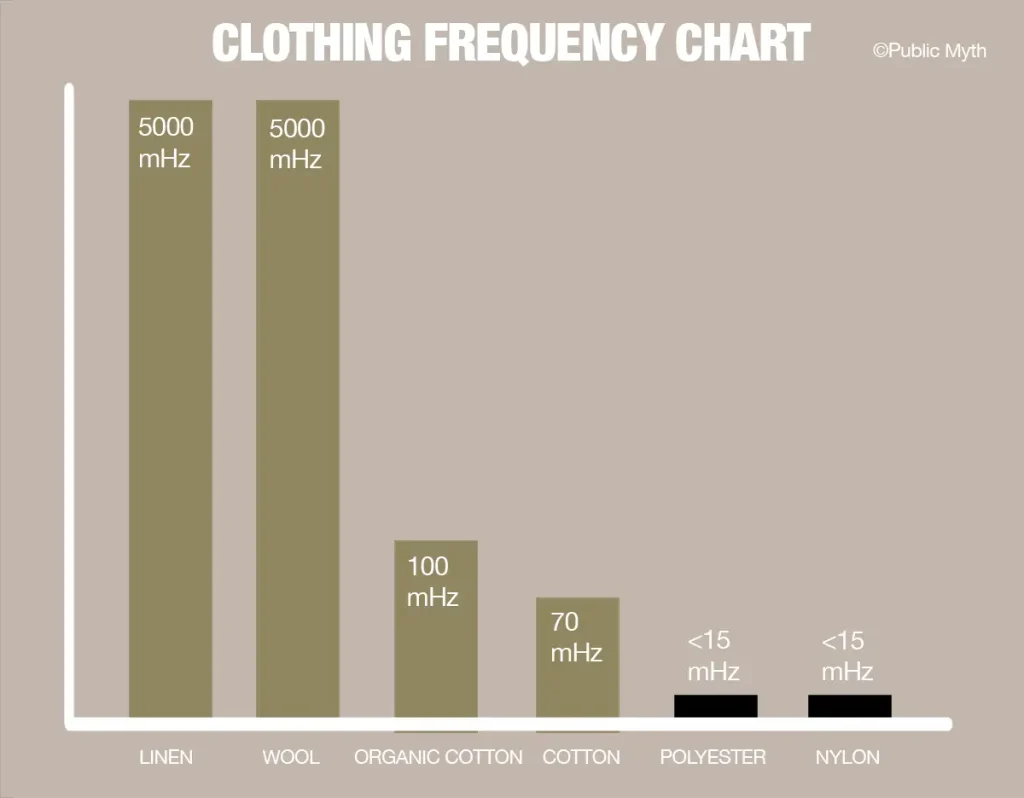High Vibration Clothing Key Takeaways:
- Natural fibers like wool, linen, and organic cotton are not only eco-friendly but also have inherent vibrational frequencies that can positively influence your energy and well-being.
- The vibrational frequencies of natural fabrics typically range between 100 mHz to 5000 Hz, whereas synthetic fabrics like polyester and nylon tend to have lower, often detrimental frequencies.
- Understanding the role of vibrational frequencies in clothing can help you make more mindful choices that align with holistic health practices.
- This article will explore the science behind vibrational frequencies in textiles. Compare natural and synthetic fabrics, and explain how the energy of your clothing can affect your overall wellness.
Introduction: The Hidden Power of Fabric Frequencies
When we think of clothing, we often focus on aesthetics, comfort, or price. But there is an overlooked aspect of clothing that is gaining more attention in holistic wellness circles: the vibrational frequencies of the fabrics we wear. Natural fibers like wool, linen, and organic cotton are widely recognized as more environmentally sustainable than their synthetic counterparts. Emerging research and holistic health practices also suggest that the material’s vibrational energy can profoundly impact our energy, mood, and health.
In this article, we will dive into the science behind vibrational frequencies in natural and synthetic fabrics. We highlight the distinct advantages that natural fibers offer for both the planet and personal well-being. Specifically, we will explore how natural fibers such as wool, linen, and organic cotton support our energy fields in ways that synthetic fabrics simply cannot.
What are Vibrational Frequencies in Fabrics?
Everything in the universe, including fabrics, has its own vibrational frequency — a unique rate at which atoms and molecules oscillate. These frequencies are measured in Hertz (Hz), a unit of frequency that represents the number of oscillations per second. When we wear certain fabrics, the vibration of those fibers interacts with our own energy field, potentially influencing our emotional, physical, and mental states.
In the context of clothing, natural fibers are believed to possess a higher, more harmonious vibrational frequency than synthetic fabrics. This alignment with our energy field can enhance well-being by promoting balance, grounding, and overall wellness. Conversely, synthetic fibers, which are typically made from petroleum-based products, tend to have lower and sometimes disruptive frequencies.

Vibrational Frequencies of Natural vs. Synthetic Fibers
Research into the vibrational frequencies of fabrics is still relatively new, but several studies and energy practitioners have observed noticeable differences between natural and synthetic materials. Below is a general overview of the vibrational frequencies of common fibers:
High Vibration Clothing Natural Fibers:
- Wool: Known for its softness, warmth, and moisture-wicking properties, wool has a vibrational frequency around 5000 mHz. This high-frequency range is believed to promote positive energy, healing, and relaxation. People also consider wool to have thermoregulatory benefits, helping maintain an optimal body temperature.
- Linen: Derived from the flax plant, linen is a durable and breathable fabric with a vibrational frequency around 5000 mHz. Linen is known for its ability to absorb and release moisture efficiently, making it ideal for warmer climates. Its high-frequency vibration is believed to support physical detoxification and emotional clarity.
- Organic Cotton: With its soft texture and hypoallergenic properties, organic cotton typically vibrates around 100 mHz. Organic cotton is free from pesticides and chemicals, allowing its natural energy to remain intact. This fabric is often linked with grounding and balancing energy.
- Other Natural Fabrics: The study from our references did not test fabrics such as hemp, bamboo, and Tencel, but these materials are made from natural organic plants, trees and are gentle on those of us with sensitive skin. People with sensitive skin are unable to wear synthetics so this maybe telling us something about these other natural fibres. Hopefully someone will test more fabrics in the near future so we can find out more.
What is the frequency of hemp fabric? While we haven’t been able to find any frequency test done specifically for hemp it is likely it would rank rather higher among other fabrics so long as it was 100% hemp. Hemp is processes similar to linen and as close to a natural state as any other natural fabric.
Synthetic Fibers:
- Polyester: One of the most commonly used synthetic fibers, polyester typically has a much lower vibrational frequency, around 15 mHz. Because it is made from petroleum, polyester’s frequency is often considered disruptive or imbalanced. This can negatively impact the wearer’s energy field.
- Nylon: Another widely used synthetic fabric, nylon vibrates in a similar low range around 15 mHz. Like polyester, nylon is derived from petrochemicals and is associated with lower vibrational frequencies. This can lead to feelings of discomfort, irritability, and fatigue when worn for extended periods.
- Acrylic: Known for its wool-like texture, acrylic is another synthetic fiber with a low vibrational frequency, typically around 15 mHz. Due to its plastic nature, acrylic is often regarded as having an even more disruptive impact on energy fields.

Why Vibrational Frequencies Matter for Well-being
The human body and mind are intricately connected to the vibrational energies around us. Whether we are aware of it or not, our environment, including the clothing we wear, has a direct effect on our energetic state.
The Positive Impact of High-Frequency Natural Fibers:
- Enhance Emotional Well-being: Wearing high-frequency fabrics like wool, linen, and organic cotton is thought to enhance emotional balance by harmonizing with the body’s energy field. These fabrics promote calmness, reduce stress, and foster a sense of peace.
- Boost Physical Health: Natural fibers can support the body’s natural healing processes by aligning with the body’s electromagnetic field. For instance, merino wool is known for its ability to regulate body temperature, supporting the immune system and enhancing overall vitality.
- Grounding and Detoxification: Linen and organic cotton are believed to support detoxification and grounding. This helps to eliminate excess energy and promote mental clarity.
The Negative Effects of Low-Frequency Synthetic Fibers:
- Energy Drain: Synthetic fibers, with their lower vibrational frequencies, can cause an imbalance in the wearer’s energy field. This disruption may lead to feelings of fatigue, irritability, or anxiety, as the body works harder to adjust to the synthetic fabric’s energy.
- Emotional and Mental Fatigue: Research in energy medicine suggests that wearing synthetic fabrics for long periods can interfere with the body’s natural frequencies. This can lead to emotional instability, difficulty concentrating, and even sleep disturbances.

Choosing the Right Fabric for Your Energy and Wellness
While the vibrational frequencies of natural fibers are just one factor to consider when choosing clothing, they provide an important lens through which to view our wardrobe choices. When selecting garments for personal wellness, it’s essential to consider both the environmental impact and how the fabric affects your energy.
- For relaxation and healing: Opt for wool, which is revered for its calming and therapeutic properties.
- For clarity and energy: Linen is a great choice for clarity, focus, and a connection to the earth’s natural rhythms.
- For grounding and comfort: Organic cotton can provide the grounding and stabilizing effects needed for overall wellness.
Conclusion: The Future of Clothing and Wellness with High Vibration Clothing
Natural fibers like wool, linen, and organic cotton offer far more than just aesthetic appeal or environmental sustainability. Their vibrational frequencies provide an added layer of value, supporting both energy and wellness in ways that synthetic fabrics simply cannot match. As we become more attuned to the energetic properties of the materials we interact with daily, making mindful fabric choices can help improve our emotional, physical, and spiritual well-being.
Choosing high-vibrational natural fibers isn’t just a choice for comfort or the environment — it’s a holistic approach to personal health and energy. By wearing fabrics that support positive vibrational frequencies, we can align our clothing choices with our broader wellness goals, contributing to a more balanced and harmonious life.
High Vibration Clothing Options



References;
Scientific Details of The Linen Frequency Study
Academia.edu Tikkun Olam to Heal the World Wearing Healing Flax-Linen Attire



Leave a Reply